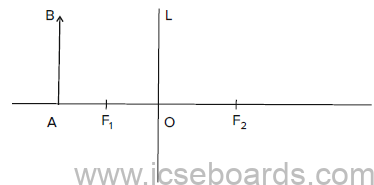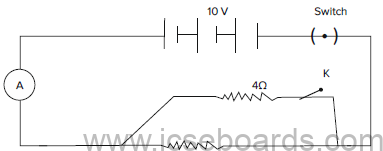Students can refer to the following Sample Paper ICSE Class 10 Physics Set F with Answers provided below based on the latest syllabus and examination guidelines issued for ICSE Physics. All specimen papers have been prepared covering all chapters given in ICSE Physics book for Class 10. You should also refer to ICSE Class 10 Physics Solutions.
Sample Paper ICSE Class 10 Physics Set F with Answers
ICSE CLASS 10
PHYSICS
SAMPLE PAPER
Time – 2 Hours
Max. Marks: 80
• You will not be allowed to write during the first 15 minutes. Utilize this time to read the question paper.
• The time given at the head of this paper is the time allowed for writing the answers.
• Attempt all questions from Section A and any four questions from Section B.
• The intended marks for the question or parts of questions are given in the brackets ().
Sample Paper ICSE Class 10 Physics Set F
SECTION A (40 MARKS)
Attempt all questions from this section.
Question 1 [10]
(a) A body is acted upon by a force. State two conditions for the work done to be zero.
(b) A piece of stone tied at the end of a thread is whirled in a horizontal circle with uniform speed by a person. Name the force which acts on the hand of the person. Mention the direction in which the force acts.
(c) State the Principle of Moments. Name a device which works on its basis.
(d) A truck weighing 5 x 103 kgf and a cart weighing 500 kgf are moving with the same speed. Find the ratio of their kinetic energies
(e) With a help of a neat diagram, explain lateral displacement with respect to a light ray passing through a glass slab.
Question 2 [10]
(a) Draw a curve showing the variation in the angle of deviation with the angle of incidence at a prism surface.
(b) Mention one subject property and one objective property of light.
(c) A coin is placed at the bottom of a vessel containing water to a depth of 12 cm. By what height does the coin appear raised when seen from vertically above. (refractive index of water = 4/3)
(d) Mention any two factors on which e.m.f of a cell depends.
(e) What is the cause of refraction of light?
Question 3 [10]
(a) State any two differences between heat capacity and specific heat capacity.
(b) The refractive index of glass is 1.5. What is meant by this statement?
(c) Explain how the
(i) Average kinetic energy and
(ii) Average potential energy of the molecules of a substance changes during change of state at a constant temperature.
(d) With reference to a household electric circuit, what do the following terms mean:
(i) Overloading
(ii) Short circuit
(e) How much electrical energy is consumed by a 12 V car headlight bulb if 4 A. Current passes through it for minutes?
Question 4 [10]
(a) Why should we not touch electrical appliances with wet hands?
(b) Why do we prefer copper as the material of the vessel used in a calorimeter?
(c) Which of the following is radioisotope in each pair? (i) C612, 𝐶614 (ii) 𝑃1530, 𝑃1532 (iii) 𝐾1939,𝐾1940 Give reason for your answer
(d) The figure shows an object AB placed on the principal axis of a lens L. The two foci of the lens are F1 and F2. The image formed by the lens is erect, virtual, and
diminished.

(e) (i) A bucket is placed below a water-tap. We can estimate the height of the water level in the bucket from a distance simply by listening to the sound. How?
(ii) Two astronauts on the surface of the Moon cannot talk to each other, why? What types of hearing aids are required by them?
SECTION B (40 MARKS)
Attempt any 4 questions from this section.
Question 5
(a) Name the type of pulley that has an ideal mechanical advantage equal to 2. Draw a labelled diagram of the pulley mentioned by you.
(b) Calculate the reading of A when K is closed

(c) Lever of length 9 cm has its load-arm 5 cm long and the effort-arm is 9 cm long.[4]
1. To which class does it belong?
2. Draw a diagram of the lever showing the position of the fulcrum F and directions of both the load L and effort E
3. What is the mechanical advantage and velocity ratio if the efficiency is 100%? What is the mechanical advantage and velocity ratio if the efficient become 50%?
Question 6
(a) (i) Define calorie. How is it related to joule (the S.I. unit of heat)? (ii) An equal quantity of heat is supplied to two substances A and B. The substance A shows a greater rise in temperature. What can you say about the heat capacity of A as compared to that of B? [3]
(b)
(i) What is meant by the statement ‘critical angle of diamond is 24o? [1]
(ii) Name two factors which affect the critical angle for a given pair of media. Show how the factors affect it. [2]
(c) (i) If in nuclear fission of a piece of uranium, 1.5 g mass is lost, how much energy in kWh is obtained?
(ii) In fission of one Uranium-235 nucleus, the loss in mass is 0.4 a.m.u. Calculate the energy released.
Question 7
(a) How are scattering of light, dispersion of light and refraction of light different from each other? Mention two points for each. [3]
(b) Give reasons: [2]
(i) Clouds appear white in color.
(ii) Infra-red radiations are used for photography in fog.
(c) A vessel of negligible heat capacity contains 10 kg of water at 40 °C. If 10 kg of ice at 0 °C is added to it, find:
(i) heat energy imparted by water in fall of its temperature from 40 °C to 0 °C,
(ii) mass of ice melted,
(iii) final temperature of mixture, and
(iv)mass of water at 0 °C in mixture. (Specific heat capacity of water = 4200 J kg–1 K–1, specific latent heat of ice = 336 k J kg–1) [3]
(d) The wavelength of x-rays is 0.01 A. Calculate its frequency. Take c = 3 x 108 ms-1 [2]
Question 8
(a) A house has a main fuse of 5 A rating. 5 bulbs each of 60 W and 2 tube-lights each of 40 W are used simultaneously. Find: [3]
(i) The current drawn from the main of 220 V
(ii) Maximum number of additional bulbs each of 100 W which can lighted simultaneously along with the above-mentioned bulbs and tube-lights.
(b)
(i) State any two differences between e.m.f and terminal voltage of a cell
(ii) State any two ways in which the internal resistance of a cell can be decreased by making changes in the construction of the cell. [4]
(c) (i) The temperature recorded by a thermometer decreases when its bulb is covered with a piece of cloth soaked in spirit. Explain why?
(ii) A bucket contains 8 kg of water at 25°C. 2kg of water at 80°C poured into it. Neglecting the heat absorbed by the bucket, calculate the final temperature of the water.
Question 9
(a) An atomic nucleus A is composed of 84 protons and 128 neutrons.
(i) The nucleus A emits an alpha particle and is transformed into a nucleus B. What is the composition of the nucleus?
(ii) The nucleus B emits a beta particle and is transformed into a nucleus C. What is the composition of the nucleus C?
(iii) Does the composition of nucleus C change if it emits gamma radiations?
(b) (i) Define specific latent heat of fusion. State its unit. [1]
(ii)Calculate the power of an electric heater required to melt 1 kg of ice at 0°C in 30s if the efficiency of heater is 40%. Take specific latent heat of ice = 336 J g-1
(c) A heating col is immersed in a calorimeter of heat capacity 50 J °C-1 containing 1.0 kg of liquid of specific heat capacity 450 Jkg-1°C-1. The temperature of the liquid rises by 10°C when 2.0 A, current is passed for 10 minutes. Find:
(i) The resistance of the coil
(ii) The potential difference across the coil. State the assumption made for the calculation
Question 10
(a) What is a nuclear reactor? What is meant by enrichment of nuclear fuel? When does a nuclear reactor become critical? [3]
(b) A mass of 0.22 kg of lead spheres is placed in a well-insulated tube. The tube is turned upside down several times so that the spheres fall through an average height of 0.5 m each time the tube is turned. The temperature of the spheres is found to increase by 8°C. If the specific heat capacity of lead is 130 J kg1 K1 deduce the number of times that the tube is turned upside down. g = 10 ms-2 (you may round off the answer to give a number)
Question 11
(i) Name the technique used to estimate the age of very old trees, plants, wood, and other such specimens. Name the isotope that forms the basis of this technique.
(ii) Describe briefly, two properties each of alpha particles and gamma radiations.